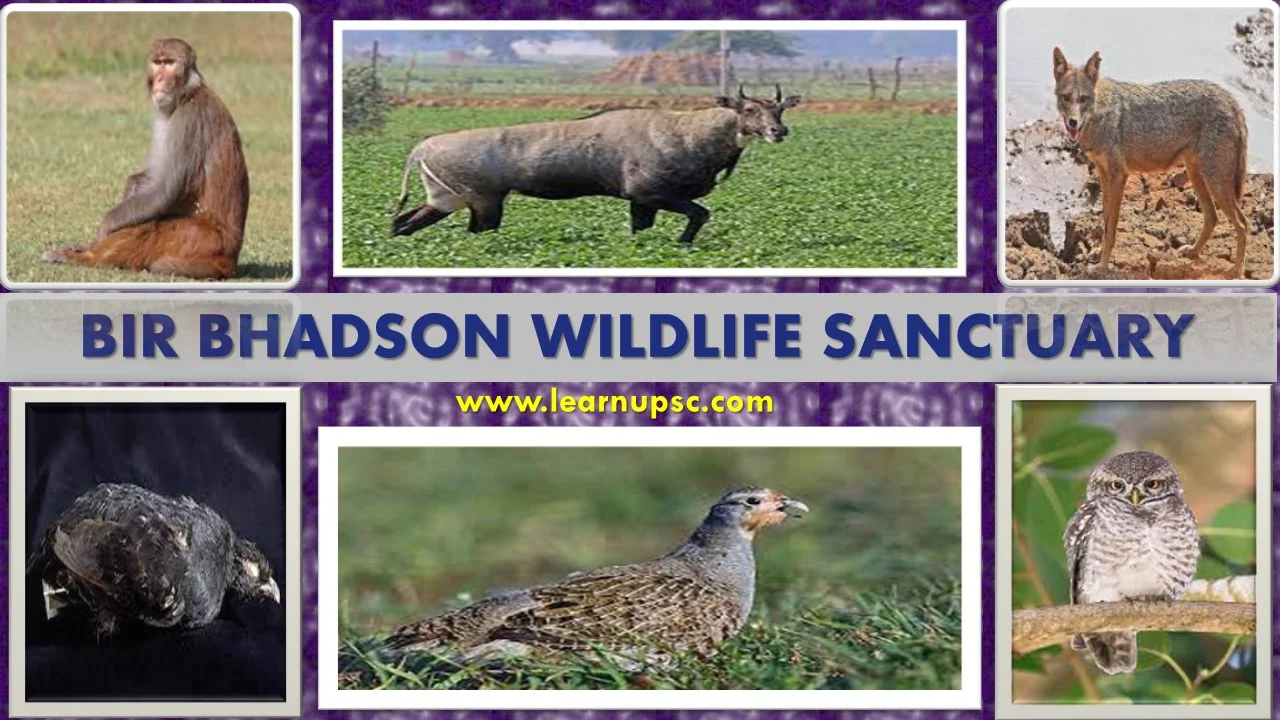Bir Bhadson Wildlife Sanctuary UPSC
The Bir Bhadson Wildlife Sanctuary is a protected area located in the state of Punjab, India.
Bir Bhadson Wildlife Sanctuary encompasses diverse ecosystems, including dry deciduous forests, grasslands, and scrublands. This variety of habitats supports a wide range of plant and animal species.
|
Table of Contents
|
Bir Bhadson Wildlife Sanctuary Location
The Bir Bhadson Wildlife Sanctuary is located in the Patiala district of Punjab, India. It falls within the jurisdiction of the Nabha tehsil of Patiala Forest Division (Wildlife). The sanctuary is situated on the Nabha-Gobindgarh road, approximately 30 km from Patiala city.
Nearest Airport:
The nearest airport to the Bir Bhadson Wildlife Sanctuary is Chandigarh International Airport, which is located in Mohali, Chandigarh. This airport is the closest major airport to Patiala, the district where the sanctuary is situated.
Nearest Railway Station:
The nearest railway station to the Bir Bhadson Wildlife Sanctuary is Nabha Railway Station. Nabha is a town located on the Patiala-Bathinda railway line and is relatively close to the sanctuary.
Bir Bhadson Wildlife Sanctuary History
The history of Bir Bhadson Wildlife Sanctuary in Punjab, India, dates back several decades. Here is an overview of its historical background:
1. Origins and Hunting Grounds: The sanctuary has its origins in the historical practice of using the area as a hunting ground. In the past, it was utilized as a "Shikargah," a hunting zone for the rulers of the region.
2. Protected Forest: Over time, recognizing the importance of conserving the area's biodiversity, the region was declared a protected forest. Initial steps toward protection were taken with the issuance of notifications.
3. Wildlife Sanctuary Declaration: The Bir Bhadson area was formally declared a Wildlife Sanctuary through Punjab Government Notification No. F-150/50 dated February 28, 1952. This marked a significant step toward the conservation of the region's flora and fauna.
4. Eco-Sensitive Zone Designation: In July 2016, the Government of India issued Notification No. 2483(E), declaring an Eco-Sensitive Zone around the sanctuary. This designation aimed to provide an additional layer of protection to the sanctuary's ecosystem and prevent adverse impacts from developmental activities.
Bir Bhadson Wildlife Sanctuary Area
The total area of the Bir Bhadson Wildlife Sanctuary is approximately 1022.63 hectares (10.2263 square kilometers), as notified by the Punjab Government.
Bir Bhadson Wildlife Sanctuary Flora
The Bir Bhadson Wildlife Sanctuary is home to a variety of flora that contribute to its diverse ecosystem. The sanctuary falls under the Northern Tropical Dry Mixed Deciduous Forest type.
Here are some of the prominent plant species that can be found within the sanctuary:
- Kikar (Acacia nilotica)
- Eucalyptus (Eucalyptus spp.)
- Phalahi (Acacia modesta)
- Jamun (Syzygium cumini)
- Beri (Ziziphus mauritiana)
- Mulberry (Morus spp.)
- Dek (Butea monosperma)
- Mesquite (Prosopis juliflora)
- Neem (Azadirachta indica)
- Shisham (Dalbergia sissoo)
- Sambal (Bombax ceiba)
Bir Bhadson Wildlife Sanctuary Fauna (Bir Bhadson Wildlife Sanctuary Animals)
The Bir Bhadson Wildlife Sanctuary is home to a diverse range of fauna, including various species of mammals, birds, and other animals. Here are some of the notable wildlife species that can be found within the sanctuary:
Mammals:
- Blue Bull (Nilgai)
- Jungle Cat
- Jackal
- Rhesus Monkeys
- Hare species
- Rodents like rats and mice
Birds:
- Peafowl (Indian Peafowl)
- Black Partridge
- Grey Partridge
- Spotted Owlet
- Rose-Ringed Parakeet
Reptiles:
- Indian Python
- Indian Cobra
- Indian Monitor Lizard
- Garden Lizard
Bir Bhadson Wildlife Sanctuary UPSC Questions
Q. In which district is Bir Bhadson Wildlife Sanctuary?
A. The Bir Bhadson Wildlife Sanctuary is located in the Patiala district of Punjab, India. It falls within the jurisdiction of the Nabha tehsil of the Patiala Forest Division (Wildlife).
Q. What is Bir Bhadson Wildlife Sanctuary famous for?
A. The Bir Bhadson Wildlife Sanctuary in Punjab, India, is famous for its significant contribution to wildlife conservation and biodiversity preservation. Here are some of the notable aspects for which the sanctuary is recognized:
(i) Diverse Flora and Fauna: The sanctuary is home to a variety of plant and animal species, including mammals, birds, reptiles, and more. Its diverse habitats, ranging from dry deciduous forests to grasslands, support a wide range of wildlife.
(ii) Conservation of Avian Species: Bir Bhadson Sanctuary provides habitat for various bird species, both resident and migratory. It's a hotspot for birdwatching and bird conservation, making it popular among bird enthusiasts.
(iii) Eco-Sensitive Zone: The sanctuary's ecological importance led to the designation of an Eco-Sensitive Zone around its vicinity. This designation aims to protect the sanctuary's ecosystem from potential adverse impacts of developmental activities.




No comments:
Post a Comment